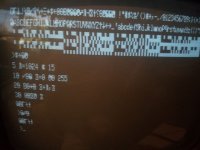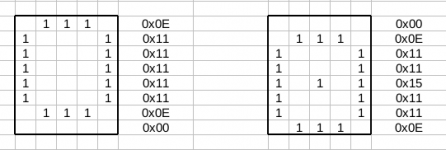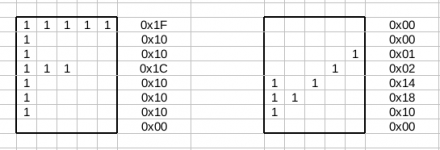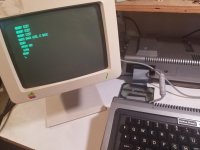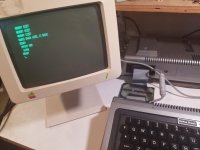Eudimorphodon
Veteran Member
In a rare fit of impulse buying I BIN'ed an untested storage-locker-find Model I keyboard unit (only) the other day, which just arrived a few hours ago. (My motivation was somewhere between thinking it's be nice to have a parts unit for my beloved other TRS-80 and thinking it might also be nice to have a test mule to use for... building things.) I have zero stars for the seller when it comes to packaging, he charged $40 for $13 worth of postage and the worst packing job I've seen for quite a while, but miraculously the unit arrived not looking any worse than it did in the listing photos. (Severely dusty but no major plastic cracks or anything.) I probably should have opened it up and looked for anything obviously bulging or scorched, but I was terminally impatient so I connected it to the monitor and PSU for my other Model I and powered it up.
Good news: It powered and spat out a "Ready" prompt. (Which actually seemed vaguely wrong in a way I couldn't put my finger on yet.) I tried typing a few lines of BASIC but it had the worst case of keybounce I've ever seen, which I figured was probably par for the course. When a mistyped line produced "What?" instead of a syntax error I realized that one of the mysterious switches on the back of the unit:
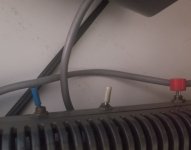
Is a switch to go between Level I and Level II BASIC. (The machine came with a buffered cable still attached to it and it has the DIN RAS/CAS/MUX modification so I know it was attached to an expansion interface.)
Anyway, bad news: the screen display wasn't particularly stable, being slightly jittery. I started messing with the switches to see what they did and (I think coincidentally) it started getting very bad, flickering side to side and eventually rolling vertically. (For the record the red pushbutton toggles between the two BASICs, I think the white toggle is for a non-Tandy lowercase modification, and the blue switch is either momentary or broken and resets the machine when poked. Wondering if they merely extended the reset button or if there's more going on, will find out when I open it.) After messing with the vertical hold on the monitor I was able to mostly stabilize it in that orientation, but the horizontal wavering continued... until it didn't. Eventually it stabilized and looked almost fine. Which it stays for a minute or two before going all wavy. Wash/rinse/repeat.
Here's a couple shots of the output. "Stable":
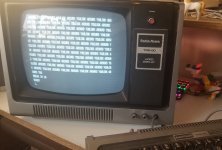
And unstable: (Actually taken a couple minutes before the "stable" shot.)

(I apologize for the not great contrast, I had some backlighting and the monitor wasn't adjusted so well. And, well, it's the original Radio Shack monitor, set expectations accordingly.)
To rule out issues with the monitor I pulled out my other keyboard unit to test, and it looks like it's fine. Wondering if anyone has a good top-of-mind idea what could cause this sort of cyclic instability?
(There may be other issues internally; at one point when I was typing I was getting what appeared to be a vibration-related issue with the character generator or another aspect of the video output chain. I didn't see that again after messing with the switches so I'm wondering if it may have been related to poor contact on the lowercase mod switch. Obviously job one is cleaning the whole thing up.)
Good news: It powered and spat out a "Ready" prompt. (Which actually seemed vaguely wrong in a way I couldn't put my finger on yet.) I tried typing a few lines of BASIC but it had the worst case of keybounce I've ever seen, which I figured was probably par for the course. When a mistyped line produced "What?" instead of a syntax error I realized that one of the mysterious switches on the back of the unit:

Is a switch to go between Level I and Level II BASIC. (The machine came with a buffered cable still attached to it and it has the DIN RAS/CAS/MUX modification so I know it was attached to an expansion interface.)
Anyway, bad news: the screen display wasn't particularly stable, being slightly jittery. I started messing with the switches to see what they did and (I think coincidentally) it started getting very bad, flickering side to side and eventually rolling vertically. (For the record the red pushbutton toggles between the two BASICs, I think the white toggle is for a non-Tandy lowercase modification, and the blue switch is either momentary or broken and resets the machine when poked. Wondering if they merely extended the reset button or if there's more going on, will find out when I open it.) After messing with the vertical hold on the monitor I was able to mostly stabilize it in that orientation, but the horizontal wavering continued... until it didn't. Eventually it stabilized and looked almost fine. Which it stays for a minute or two before going all wavy. Wash/rinse/repeat.
Here's a couple shots of the output. "Stable":

And unstable: (Actually taken a couple minutes before the "stable" shot.)

(I apologize for the not great contrast, I had some backlighting and the monitor wasn't adjusted so well. And, well, it's the original Radio Shack monitor, set expectations accordingly.)
To rule out issues with the monitor I pulled out my other keyboard unit to test, and it looks like it's fine. Wondering if anyone has a good top-of-mind idea what could cause this sort of cyclic instability?
(There may be other issues internally; at one point when I was typing I was getting what appeared to be a vibration-related issue with the character generator or another aspect of the video output chain. I didn't see that again after messing with the switches so I'm wondering if it may have been related to poor contact on the lowercase mod switch. Obviously job one is cleaning the whole thing up.)

